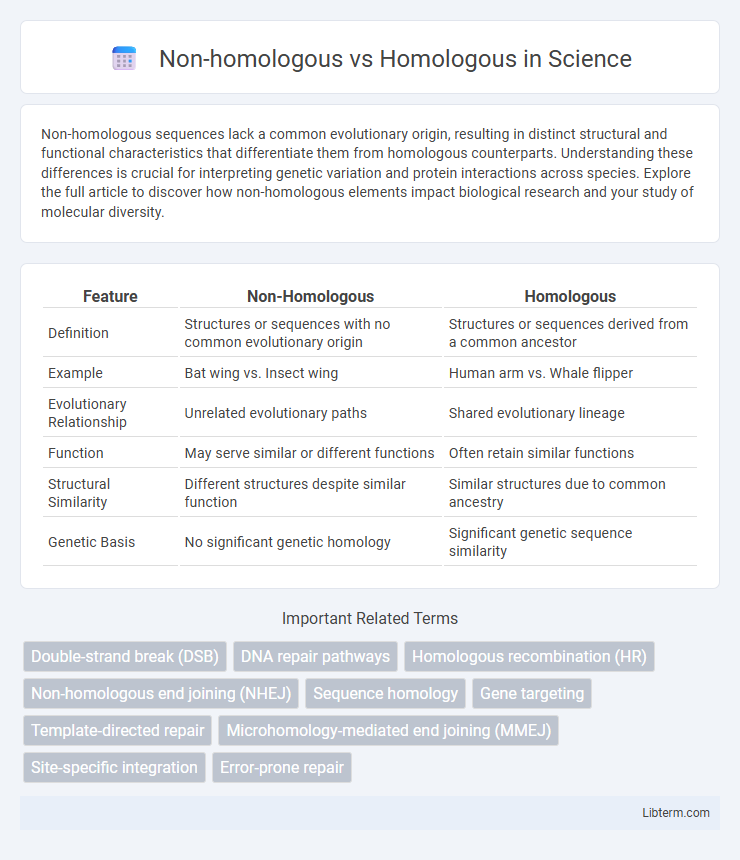Non-homologous sequences lack a common evolutionary origin, resulting in distinct structural and functional characteristics that differentiate them from homologous counterparts. Understanding these differences is crucial for interpreting genetic variation and protein interactions across species. Explore the full article to discover how non-homologous elements impact biological research and your study of molecular diversity.
Table of Comparison
| Feature | Non-Homologous | Homologous |
|---|---|---|
| Definition | Structures or sequences with no common evolutionary origin | Structures or sequences derived from a common ancestor |
| Example | Bat wing vs. Insect wing | Human arm vs. Whale flipper |
| Evolutionary Relationship | Unrelated evolutionary paths | Shared evolutionary lineage |
| Function | May serve similar or different functions | Often retain similar functions |
| Structural Similarity | Different structures despite similar function | Similar structures due to common ancestry |
| Genetic Basis | No significant genetic homology | Significant genetic sequence similarity |
Introduction to Homologous and Non-homologous Concepts
Homologous concepts refer to similarities in structure or genetics derived from a common ancestor, serving as fundamental evidence in evolutionary biology. Non-homologous concepts describe features or functions that appear similar but have independent origins, often resulting from convergent evolution. Understanding the distinction between homologous and non-homologous elements is crucial for accurate phylogenetic analysis and classification of species.
Defining Homologous: Meaning and Examples
Homologous refers to structures or sequences in different species that share a common ancestral origin, exhibiting similar anatomical features or genetic sequences due to evolutionary descent. For example, the forelimbs of humans, bats, and whales display homologous characteristics, as they evolved from a common vertebrate ancestor despite serving different functions. In genetics, homologous chromosomes carry corresponding genes inherited from each parent, aligning during meiosis to ensure genetic diversity.
Understanding Non-homologous: Meaning and Examples
Non-homologous refers to structures or sequences that do not share a common ancestry or evolutionary origin, often exhibiting functional or structural differences despite superficial similarities. Examples include non-homologous chromosomes in genetics, which differ in gene content and shape, or non-homologous end joining (NHEJ) in DNA repair, a process that joins DNA fragments without homology. Understanding non-homologous concepts is crucial for distinguishing between unrelated biological features and mechanisms in molecular biology and genetics.
Key Genetic Differences: Homologous vs Non-homologous
Homologous chromosomes contain the same genes at identical loci but may carry different alleles, allowing for genetic recombination during meiosis. Non-homologous chromosomes differ in gene content and structure, lacking sequence similarity and do not pair during meiosis. These key genetic differences influence inheritance patterns, genetic diversity, and chromosomal behavior in cellular processes.
Homologous Recombination: Mechanisms and Importance
Homologous recombination is a precise DNA repair mechanism that uses a homologous sequence as a template to accurately fix double-strand breaks, maintaining genomic stability. Key proteins such as RAD51 and BRCA1 facilitate strand invasion and exchange during this process, ensuring error-free repair and genetic diversity during meiosis. This mechanism is crucial for preventing mutations that could lead to cancer and plays a vital role in genetic engineering and gene therapy applications.
Non-homologous Recombination: Pathways and Roles
Non-homologous recombination involves the direct joining of DNA ends without the need for a homologous template, primarily through pathways such as non-homologous end joining (NHEJ) and microhomology-mediated end joining (MMEJ). These mechanisms play crucial roles in repairing double-strand breaks, maintaining genomic stability, and facilitating V(D)J recombination in immune system development. Dysregulation or errors in non-homologous recombination pathways can lead to chromosomal translocations and contribute to carcinogenesis.
Biological Functions and Applications
Non-homologous and homologous sequences differ in their biological functions, with homologous sequences sharing a common ancestry and often performing similar roles in genetic repair or recombination processes. Homologous recombination is crucial for DNA repair, genetic diversity in meiosis, and targeted genome editing techniques like CRISPR-Cas9. Non-homologous mechanisms, such as non-homologous end joining (NHEJ), facilitate the rapid repair of double-strand DNA breaks without requiring sequence similarity, playing a vital role in immune system development and gene therapy applications.
Clinical and Biotechnological Relevance
Non-homologous and homologous sequences differ significantly in clinical and biotechnological applications, influencing gene therapy approaches and genome editing precision. Homologous recombination enables targeted genetic modifications with high accuracy, essential for correcting genetic disorders and advancing personalized medicine. Non-homologous end joining, while error-prone, facilitates rapid DNA repair and is harnessed in CRISPR-Cas9 technologies for efficient gene disruption and functional genomics studies.
Advantages and Limitations of Each Mechanism
Non-homologous end joining (NHEJ) provides rapid DNA double-strand break repair without requiring a homologous template, making it efficient in non-dividing cells but it often leads to insertions or deletions, compromising genetic integrity. Homologous recombination (HR) offers high-fidelity repair by using a sister chromatid as a template, thus preserving genetic information; however, its activity is limited to the S and G2 phases of the cell cycle, restricting its use in non-replicating cells. Both mechanisms are essential for cellular survival, with NHEJ's speed suitable for immediate repair and HR's accuracy crucial for maintaining genome stability during replication.
Summary Table: Homologous vs Non-homologous Comparison
The summary table comparing homologous and non-homologous structures highlights key differences in evolutionary origin, function, and morphology. Homologous structures share a common ancestor and often exhibit similar anatomical features despite functional divergence, whereas non-homologous structures arise independently, showing analogous functions without common ancestry. This distinction aids in understanding evolutionary relationships and adaptive mechanisms across species.
Non-homologous Infographic

 libterm.com
libterm.com